May 6, 2010 — Forty-eight years ago Monday, astronaut Scott Carpenter splashed down in the Atlantic Ocean after circling the planet three times in "Aurora 7," his Mercury spacecraft. The flight on May 24, 1962, made him the just the fourth man in space and the second American to orbit the Earth.
Flashing forward almost five decades and 1,115 miles to the northeast, astronaut Tom Marshburn "splashed up" on Sunday from the floor of the Carpenter basin off the coast of Key Largo, Florida. A veteran of a 2009 space shuttle mission on which he came close (mere inches) to being the 500th in space, Marshburn was the 39th astronaut to turn aquanaut.
Carpenter, who for 28-days in 1965 served on the Navy's Sealab II off the coast of California, was the first.
As NASA's latest astronaut-aquanaut, Marshburn spoke with collectSPACE.com while he was still three days from surfacing from NOAA's Aquarius lab as part of the NASA Extreme Environment Mission Operations (NEEMO) 14th expedition.
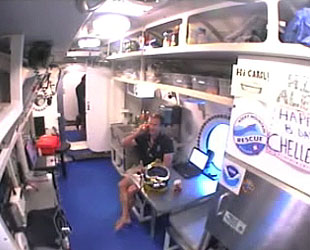
NEEMO aquanaut Tom Marshburn sits in the Aquarius lab's main lock while talking with collectSPACE.com. (UNCW) |
collectSPACE (cS): Can you set the stage for our readers where you are?
Tom Marshburn (TM): I am getting close to the end of a two-week mission living here in Aquarius, a 400-foot living space down here about 70-feet down at the bottom of the ocean, the Atlantic, off the coast of Key Largo. This is the only scientific underwater laboratory in the world. With NASA, we are able to be down here to do some NASA research as well do some training down here. We're living in two-and-a-half atmospheres.
We are able to leave the habitat and go on what we call EVAs, or extravehicular activities, out on the ocean floor. We use dive helmets that allow us to leave the habitat for two to three hours at a time, not only to continue to breath but communicate and talk to my crewmembers.
cS: How does the NEEMO mission relate to your role as an astronaut?
TM: There is a very direct benefit of getting to train living in a dangerous environment. This is actually the closest simulation to spaceflight that I have ever had.
The psychological effects of living in a dangerous place, close confinement, following rigorous procedures, paying attention to life support systems, all of that is fairly close to spaceflight, so it is great training for us and keeps us sharp.
But specifically down here on this mission, we are able to take advantage of the underwater environment to actually evaluate spacesuit designs and lander craft and a rover on the bottom of the ocean. We can take advantage of the buoyancy of the water to alter the Gs and work as if we were working on a lunar or Martian surface and do lots of spacesuit and spacecraft evaluations. Most of our tasks are like that. We are going to do some exploratory work as well, going out to the coral reef and making observations out there.
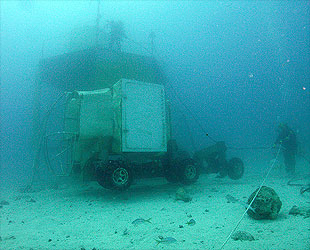
As one aquanaut stands atop the lander and the other is on the ocean floor, they begin to lift the exploration vehicle. (NASA) |
cS: How would compare the views out the window? Which is more spectacular, watching the Earth rotating below or watching marine life swim by?
TM: Certainly I would have to say looking out the window at the Earth from space is as, one of my crew mates described, "You are looking at all of life that we know of, as opposed to one type of life here on Aquarius."
For me, seeing the Earth from space has a very profound effect, something you think about for the rest of your life. Here it is incredibly beautiful, fascinating and our attention is always drawn to it but I do not think it has that same feeling that you get when you look out at the Earth from space.
cS: Speaking of looking out, can you share what you have done on some of your EVAs?
TM: We've focused our attention since the beginning on spacecraft and spacesuit designs. I understand we have about 3400 or 3500 data points on each of us evaluating a lot of activities.
What would it take to offload a very heavy object, or even a light object, off of a lander that is 20-feet up in the air? How easy would it be to move around a rover and get in and out of it? To take an incapacitated crew member and hoist them up onto the rover and use different techniques for that?
In each case, there were different weights, our spacesuit weights, and a different center of gravity. We're wearing these backpacks where it shifts our center of gravity so we can get an idea of what are really the operational or usuability limits of this spacesuit that has various center of gravity.
We want to circle in on the right size for a spacesuit and so this is all useful data, stuff that they didn't really have time to do in the Apollo-era. They had incredible designs for their spacesuits, we're just trying to make them better and more usuable for when we go to Mars.
cS: As you've mentioned Apollo, the history of astronaut- aquanauts dates even earlier to Scott Carpenter. Is there a camaraderie among those who have been to both outer and inner space?
TM: I suspect so, they talk about it after they have been down here and now I've just become one, so when I come back I'll be able to better answer.
I think there is and particularly when you have done both, both astronaut and aquanaut. Certainly there is a lot of curiousity what it is like to live and work down here.
cS: How do you get down there? How do you come back up? Are there dangers involved?
TM: A lot of danger in coming up. Coming down is very easy: you scuba dive. You put on your scuba gear, you dive in, and if you've ever been on a scuba trip, you dive down to about 60 feet and you go up under the habitat. There's no big hatch you have to open or anything. It is just a pool of water and you step up and you're inside the habitat.
You are living under pressure, the atmospheric pressure matches the sea pressure at this level, so it means the surge of the ocean changes the pressure in here. Our ears pop a lot and there are lot ocean surges when the weather changes above the surface.
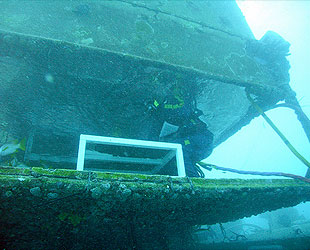
As an EVA comes to a completion, an aquanaut enters the wet porch of the habitat to remove his equipment. (NASA) |
After you've lived in two-and-a-half atmosphere for a little while, the nitrogen has been driven into your body and then you have to very slowly decompress to get up safely or otherwise you get the bends. It could kill you actually if the nitrogen bubbles come out too fast.
So coming back is dangerous. That is going to be a very slow, staged process over about a day when we come to the end of our mission on Saturday. We'll close off the habitat completely, so the water is out, and then slowly decompress over about a 16-hour period so that we don't get the bends. Then we'll be at one atmosphere inside the habitat and all we have to do is put on our scuba gear and hop back out again and surface topside.
cS: The decompression process sounds like the campout you did in the space station's airlock before going out on a spacewalk. Is that an accurate comparison?
TM: That is exactly what we do in the airlock in space.
We campout overnight at 10.2 psi for the same reasons, so we do not get the bends. In the spacesuit we're only at 4.2 or 4.3 psi and we're breathing 100 percent oxygen so we can move around in the suit.
cS: As we speak, the astronauts on space shuttle Atlantis are conducting spacewalks similar to your own to replace batteries for the station's solar arrays. Which is harder, a spacewalk or an EVA underwater?
TM: The EVAs underwater I would say are not as tough. They didn't have time to develop these EVAs down here with nearly as much time.
We had about a year to get ready for the space EVAs but those are more difficult. Working in zero gravity, first of all is more difficult. Things get away from you, float away, they don't go in a predictable direction like towards your feet if you drop them.
There was a lot more step-by-step work that needed to be done in the spacewalks. There were easily a thousand steps you had to memorize, you had to get them down just right in order to do something like the battery change and it had to be very carefully choreographed.
There is not nearly the same intensity that is required to work down here. Physically it is pretty demanding working on the ocean floor. You're wearing a lot of weight because you want to simulate wearing a heavy spacesuit.
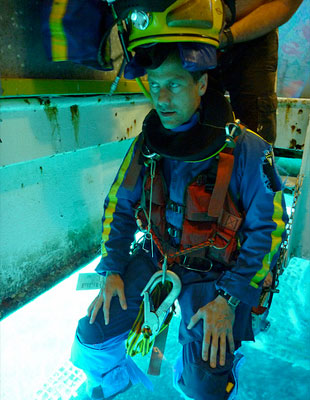
Marshburn getting suited for an EVA outside the habitat. (NASA) |
In space it's also very demanding, very fatiguing, probably more so in space but for different reasons. There are temperature changes, your forearms get more tired in space, you're really wiped out and want to have a good hot meal, a shower and a nap after a spacewalk.
But [the mission] is a lot of fun to follow. They are doing a similar job in a different place on the station but a very similar job to what I did.
cS: How well can you keep up with your fellow astronauts while they are in space and you're underwater?
TM: We were able to watch the launch when it happened, except for any time delays for communication. We were actually getting ready to go out on one of our floor walks. Our commander [Chris Hadfield] was especially interested because Atlantis was the shuttle he first flew on and this was Atlantis' last flight. So it was a neat time for him to see that.
We were able to watch the beginning of a spacewalk. Our limitation is not only the wireless dropping in and out here, but mostly our work pace being able to follow the mission in real time. But we've been getting the updates and know what they are doing and actually sent a couple of e-mails to some of my friends in the astronaut corps asking for details like that spacewalk, so we have been able to keep pretty close tabs.
cS: Getting back to your own EVAs, can you describe the area you are in? It is named Carpenter basin after Scott Carpenter right?
TM: Yes, Carpenter basin, and what we have are small ridges of coral radiating outward and then of course all of the life that is within the coral. Today, we're going out and getting our bearings and naming the large outcrops and later on today and perhaps sometime tomorrow we'll get into detail, taking photographs and observing the details within the ridges of coral.
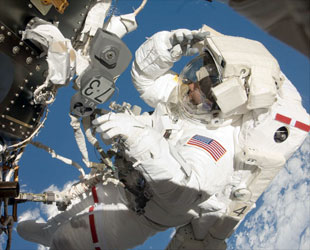
Marshburn spacewalking outside the International Space Station (ISS) in July 2009 during the STS-127 mission. (NASA) |
cS: The last time we spoke was before your space shuttle mission last year, but if I remember correctly, your voice then was deeper.
TM: You know, I noticed that as soon as I got here and my family does not notice it, maybe because of the cell phone transmission. But I think you're right. I think your voice changes quite a bit, it's a little bit higher here due to the increasd air density.
Other effects are... I still haven't learned how to whistle down here. I can't whistle. I practice and I am still trying to get it back again.
I have noticed other things, like when you drop a tea bag it doesn't just fall to the floor like it does topside. It kind of flutters like a leaf. So the air density is higher.
Another thing really interesting — you need to be very careful with the hot water because water boils at a higher temperature here. You can really scald yourself and not realize it, water being hotter at a boiling temperature than at one atmosphere. So, our food preparation — we don't have a stove here but we have a hot water dispenser — we have to be careful not to dig in to quickly.
cS: I understand your commander, Chris Hadfield, brought with him a guitar and it might be the first guitar played on the ocean floor. Does it sound different?
TM: It was the first foldable guitar, at least according to the techs who are here with us. It did not [sound different]. We have a little amplifier down here and so that probably took care of any differences. It did not sound or feel any different. I used to play guitar as well and had a chance to try it out. That was all the same I think.
cS: Speaking about the crew's activities, have customs developed among the NEEMO residents?
TM: The environment you live in define the customs. Our environment is very, very tight except when we are out on EVAs. We are surrounded by the machinery that keeps us alive. To us, it is aesthetically beautiful because it keeps us alive, but otherwise it is a lot of valves and pipes.
So, customs that developed are to be able to take your work with humor and keep motivation high, so you have a lot of fast calls, quick calls to keep everyone focused on what they are doing.
You sort of stop asking permission for passing somebody, or saying "excuse me," because you are always bumping into each other. Politeness does exist, it is just another type of politeness.
It seems to work really well. This has been a great crew to work with. I've had a blast. There are a lot of technqiues you can adopt so that there is really no friction at all and you have a lot of fun.
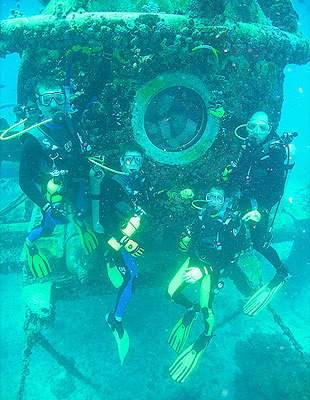
Outside Aquarius from l to r: Chris Hadfield, Andrew Abercromby, Tom Marshburn, and Steve Chappell. (NASA) |
cS: Since you mention fun, as they say, time flies when you are having fun. So which seemed to go by quicker: your 15-day mission on the shuttle and station or your two weeks on Aquarius?
TM: Oh that's a great question! Boy, you know I look back on the shuttle flight and it's a blink because every second was so full of new experiences. Just existing in space, floating in zero gravity, to me was incredibly fascinating ...and frustrating in space. Even brushing your teeth in space was something fun and exciting to do, trying all kinds of new things.
Here, brushing your teeth is about the same as on the ground however, there is plenty going on outside the window and other aspects are exciting.
So spaceflight probably went by faster. This was not quite as fast, and actually our work pace is not quite as busy as on the shuttle. But still this has gone by quickly. We're really shocked that we're at mission day 11 and that we're going to be starting to decompress in a couple of days is hard to believe.
cS: We've been talking at practically real time, but you've also been working with delayed communications between Aquarius and your topside mission control, simulating the 20-minute delay astronauts will experience communicating from Mars. How has that gone?
TH: So far, it has been going pretty good.
In terms of getting important information back and forth, operational information, there are new habits you have to adopt: that is, constantly checking your e-mail because you might ask a question and you expect an answer back, but you're not going to sit around for the answer so you leave your laptop and you have to remember to come back and get the answer. So I think there is a lot more monitoring of your communication.

Marshburn sits in the sleeping quarters in Aquarius. (NASA) |
And then we found out that video is good. The benefit is just seeing the faces of the people who you are working with. It is important to keep that link, though it is probably not the best way to send technical information.
So, we are working out ways of doing that and it is really fascinating. We haven't seen any real problems with it. In some ways it is desirable because any crew likes to have a little bit of autonomy, which this kind of communication mode gives us.
cS: Are you ready to come topside or could you stay on Aquarius longer?
TH: I think we're all ready to come up. If the mission had us down here longer, there is certainly nothing stopping us from being down here.
It is true for spaceflight, or so I've heard, for long duration flights that you have to get your mind set on the time you know you are going to launch and come home and you can adapt to whatever that is. You have to readapt if that changes, if your return trip home gets delayed for some reason.
Because you adapt to it, you begin to say "okay, a couple of more days and I can have a nice cup of brewed coffee or a long hot shower" — we have hot showers here, but not long ones — and we're certainly missing family. So I think people will be ready to come up because we've adapted to knowing when we are coming home.
